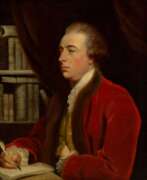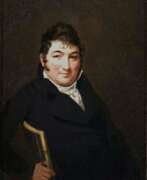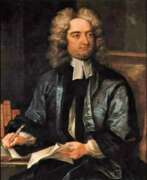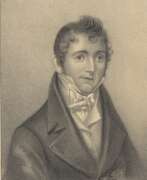Journalists 18th century


Jean-Baptiste-Joseph Breton de la Martinière was a French stenographer, journalist, translator and writer.
Breton was a founding member of a group of stenographers of the Legislative Assembly and stenographed debates from 1792. He became parliamentary reporter in 1815 and remained so until his death. He was also one of the founders of Le stenographer of the Chambers and the Gazette des tribunals. A polyglot and knowing almost all the languages of Europe, Breton often acted as an interpreter in the courts.
Breton de la Martinière published books on China, as well as on Egypt and Syria, where he used materials by the scholar Jean-Joseph Marcel, who accompanied Napoleon to Egypt in 1798. The text contains much information on the customs, religion, and antiquities of Egypt, as well as a fascinating description of the recent French occupation.


Joseph Dennie was an American writer, journalist, and major literary figure of the early 19th century.
Dennie graduated from Harvard College, became a lawyer, but became active in writing. In 1801, he founded a periodical called The Port Folio, which became the most prominent literary weekly of its time in America. It was also the first important political and literary journal in the United States.
As founder of the Tuesday Club, Dennie was the center of Philadelphia's aristocratic literary circle in the early 19th century and for a time was the leading literary critic in the country. He ridiculed the simplistic and crude nature of Native Americans and opposed democratic innovations. He also encouraged talented young writers.


Philip Morin Freneau was an American publicist, editor, and known as the "poet of the American Revolution".
After graduating from Princeton University, Freneau taught school and studied to become a minister. With the outbreak of the American Revolution, he began writing scathing satire on the British and the Tories. During a two-year voyage to the Caribbean islands, he created the poems "The Beauties of Santa Cruz" and "The House of Night," and in 1778 he became involved in the war. After his release from British captivity, Freneau wrote a book in verse, "The British Prison Ship" (1781).
After serving as a sea captain for several years, Freneau took up journalism. In his National Gazette newspaper in Philadelphia, he sharply criticized George Washington.
Freneau's poetry, which accompanied him throughout his life, covers a variety of subjects, including political situations, American Indians, nature, the sea, and naval battles. His political poems are often satirical, but his nature poems are very lyrical.


John Hawkesworth was a British writer, playwright and book editor.
In collaboration with Samuel Johnson, Hawkesworth founded the periodical The Adventurer. He wrote poems and articles for this publication and for the Gentleman's Magazine, and edited the works of Swift (1754-1755). Hawksworth adapted several literary works for the theater and also composed various original dramatic works himself.
John Hawksworth was commissioned by the British Admiralty to compile An Account of Voyages made in the Southern Hemisphere (1773), devoted mainly to the exploratory voyages of Captain James Cook.


John Hill was a British botanist, pharmacologist and physician, geologist, writer and journalist.
Hill edited the monthly British Magazine for several years, and also wrote a daily society gossip column in The London Advertiser and Literary Gazette. His satirical, often on the edge of propriety articles were often the cause of scandals. Hill also wrote novels, plays, and scientific works on geology, medicine, philosophy, and botany.
In 1759, the first of the 26 volumes of his Plant System was published. This voluminous work contained descriptions of 26,000 different plants and 1,600 illustrations. For this long work, Hill received the Order of Vasa from the Swedish king and began calling himself Sir.


Samuel Relf was an American journalist and author.
Relf became known as the author of the novel Infidelity, or Victims of Sentimentality, first published in 1797 in Philadelphia. This scandalous book has been called "the first independent Philadelphia novel" to deal with the consequences of adultery. As a journalist, Relph built his work on stories from newspaper articles and in general, it was initially conceived as a magazine article. The book caused considerable controversy in post-revolutionary America.


Johann Gottfried Richter was a German journalist and translator.
Without finishing his studies at the University of Leipzig, Richter in 1787 went to Moscow to work as a governess. Soon he mastered the Russian language well and thanks to his literary abilities made acquaintances with publishers and writers, in particular, with Nikolai Mikhailovich Karamzin.
After spending 16 years in Russia, Richter returned to Germany in 1803 and, at Karamzin's request, became an advisor to Duke Carl August and Imperial Counselor for Russia. In 1808 he moved to Eilenburg, where he spent the last two decades of his life.
Richter was an important conduit of Russian culture in Europe, refuting European perceptions of Russians as slumbering savages. In collaboration with the illustrator Christian Gottfried Heinrich Geisler, he described Russian manners and customs and translated Karamzin's works, Russian fairy tales and poems into German. Together with the Riga publisher Johann Friedrich Hartnoch the Younger, Richter published the journal Russian Miscellaneous, from which European readers learned about the Russian way of life, the history and geography of the Russian Empire, and Russian literature.


Anne Royall, née Newport, was an American writer, newspaper editor and traveler, one of the first women journalists in the United States.
After the death of her husband William Royall in 1813, Anne was left destitute, but she did not despair and completely changed her life. She was about 50 years old when she set out to travel the country and describe what she saw. She visited Baltimore, Philadelphia, New York City, Albany, Springfield, Hartford, Worcester, Boston, and New Haven. In each city, she asked respected citizens for interviews and subscriptions to her future books. She made detailed notes on each town's population, industry, physical description, local transportation, regional dialects, fashions, and the character of its inhabitants.
In all, Anne Royall wrote ten volumes of travel books. She was 57 years old when she published under a pseudonym her first book, The Traveler: Sketches of History, Life, and Manners in the United States (1826), which provides a unique look at American life in the early nineteenth century. His first novel, The Tennessean, was published in 1827, followed by several others.
At the age of 62, in her home in Washington, D.C., Royall began publishing her own newspaper, Paul Pry (1831-1836) and then The Huntress (1836-1854). She exposed bribery and corruption and made many powerful enemies. Nevertheless, it is known that the intrepid journalist during her life met and talked with every man who occupied the presidential chair, from George Washington to Abraham Lincoln.


Frederic Shoberl or Frederick Schoberl was a British journalist, editor, translator, writer and illustrator.
Along with publisher Henry Colburn, Schoberl was the creator and co-owner of the New Monthly Magazine, which began publication on February 1, 1814. He acted as editor for a time, publishing original articles and reviews. Frederick Schoberl worked closely with publisher Rudolf Ackerman (1764-1834) for a long time, editing his Vault of Art from March 1809 to December 1828. He also kept Ackerman's English yearbook, Nezabudka, from 1822 to 1834, and worked on many other publications.
In addition to his editorial work, Frederick Schoberl produced excellent illustrations, for example for the book The World in Miniature: Hindustan, which was published in London by Ackerman in the 1820s.


Jonathan Swift was a British-Irish writer, essayist, philosopher, and author of the world-famous satirical novel Gulliver's Travels.
Swift also wrote numerous works, including The Tale of the Barrel (1704), An Argument Against the Abolition of Christianity (1712), and A Modest Proposal (1729). Almost all of Swift's satirical works were published anonymously, giving the author wide latitude in expressing his talent as a satirist.
Swift was a clergyman, made a career in London, became the chief pamphleteer and political writer of the Tories and headed the Tory journal "The Inspector", and then returned to Ireland, where he created his major life's work.
The four-part novel Gulliver's Travels, Jonathan Swift's greatest satire, was first published in 1726 and has since been reprinted hundreds of times in many languages around the world. The author describes in an engaging style the different races and societies that Gulliver encounters on his travels to ridicule the many errors, follies, weaknesses and vices to which people and society at large are subject. The author's boundless imagination, bitter irony, keen intellect and brilliant language give this work a world-class scope.


George Watterston is an American politician, author and journalist.
He graduated from the Charlotte Hall Military Academy with a law degree. But, apparently, he soon became so disappointed in the profession that he began to write poetry and prose, in which he portrayed lawyers in a very unsightly form. His first novel "The Lawyer, or The Man as he ought not to be" Watterston published in 1808. This poignant novel is ostensibly a confession of a corrupt lawyer and seducer in the spirit of Stephen Burroughs' Memoirs of Stephen Burroughs. Watterston's ironic take on the didactic novel straddles the line between Charles Brockden Brown's gothic thrillers and dark comedy. He also wrote the novel Glencarne or the Disappointments of Youth (1810), the play Child of Sentiment (1809), and the poem Scenes of Youth (1813), among others.
After the end of the War of 1812, President James Madison appointed Watterston as Librarian of Congress, the third person to hold the position and the first to be solely responsible for it. He held the position from 1815 to 1829.
In 1813, Watterston became editor of the Washington City Gazette. And after his dismissal from Congress, he became editor of the National Journal. He continued a productive literary and journalistic career until his death.


Samuel Woodworth was an American writer and poet, playwright and journalist.
After completing his apprenticeship as a printer, Woodworth traveled to New Haven, Connecticut, and worked for the Connecticut Herald newspaper. During the War of 1812, he edited a weekly newspaper called The War and others. He also wrote several successful operettas.
Samuel Woodworth was a popular poet in the 19th century and is remembered today as the author of the sentimental poem "The Old Oak Bucket".



